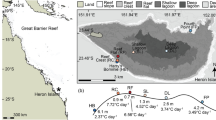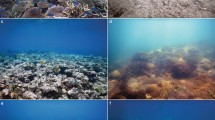Abstract
The authors investigated the response to experimentally elevated water temperature in genotypes of Pocillopora damicornis from three coral reefs in the upwelling Gulf of Panama and four coral reefs in the non-upwelling Gulf of Chiriquí, Panamanian Pacific. Sea-surface temperature in the Gulf of Panama declines below 20 °C during seasonal upwelling, while in the thermally stable Gulf of Chiriquí, the temperature ranges from 27to 29 °C. Genotypes of P. damicornis from the seven locations were determined by allozyme electrophoresis. The most abundant genotype at each location was selected for a thermal tolerance experiment where corals were exposed to water temperature of 30 °C (1 °C above ambient) for 43 days. Four site coral genotypes can be uniquely differentiated by the GPI locus, two by the LGG-2 locus, and two by a combination of the MDH-1, LGG-2, and LTY-3 loci. A visual assessment of the coral condition after exposure to an elevated temperature showed that corals from localities in the non-upwelling environment retained a normal to slightly pale appearance, while corals from the upwelling environment bleached and their polyps were mostly retracted. A two-way ANOVA confirmed that corals were significantly affected by water temperature and locality. The zooxanthellae were also significantly affected by the interaction of elevated temperature and locality of the corals. Mean zooxanthellae density decreased by 25 and 55%, respectively, in experimentally heated corals from the non-upwelling and upwelling environments. Low concentrations of photosynthetic pigments per live area of the corals were the norm in corals under elevated temperature. The mean concentration of chlorophyll a per live area of the corals was reduced by 17 and 49%, respectively, in heated corals from the non-upwelling and upwelling sites. Coral genotypes from the upwelling Gulf of Panama demonstrated higher vulnerability to thermal stress than coral genotypes from the non-upwelling Gulf of Chiriquí. However, the latter showed greater differences in their responses. Thus, even at small geographic scales, corals can display different levels of tolerance to thermal stress. The difference in thermal tolerance between corals from upwelling and non-upwelling environments is concomitant with greater genetic differences in experimental corals from the thermally stable Gulf of Chiriquí compared with corals from the upwelling Gulf of Panama.




Similar content being viewed by others
References
Baker AC (1999) The symbiosis ecology of reef-building corals. PhD Dissertation, University of Miami. 120 pp
Baker AC (2001) Reef corals bleach to survive change. Nature 411:765–766
Baker AC, Rowan R (1997) Diversity of symbiotic dinoflagellates (zooxanthellae) in scleractinian corals of the Caribbean and eastern Pacific. Proc 8th Int Coral Reef Symp 2:1301–1306
Black NA, Voellmy R, Szmant AM (1995) Heat shock protein induction in Montastrea faveolata and Aiptasia pallida exposed to elevated temperatures. Biol Bull 188:234–240
Bradford MM (1976) A rapid and sensitive method for the quantitation of microgram quantities of protein utilizing the principle of protein-dye binding. Anal Biochem 72:248–254
Brown BE (1997) Coral bleaching: causes and consequences. Coral Reefs 16, Suppl S129–S138
Brown BE, Dunne RP, Goodson MS, Douglas AE (2000) Marine ecology: bleaching patterns in reef corals. Nature 404:142–143
Brown BE, Dunne RP, Goodson MS, Douglas AE (2002) Experience shapes the susceptibility of a reef coral to bleaching. Coral Reefs 21:119–126
Buddemeier RW, Fautin DG (1993) Coral bleaching as an adaptive mechanism, a testable hypothesis. BioScience 43:320–326
Coles S, Jokiel PL (1978) Synergistic effects of temperature, salinity and light on the hermatypic coral Montipora verrucosa. Mar Biol 49:187–195
Coles SL (1997) Reef corals occurring in a highly fluctuating temperature environment at Fahal Island, Gulf of Oman (Indian Ocean). Coral Reefs 16:269–272
D’Croz L, Del Rosario JB, Gómez JA (1991) Upwelling and phytoplankton in the Bay of Panama. Rev Biol Trop 39(2):237–245
D’Croz L, Kwiecinski B, Maté JL, Gómez JA, Del Rosario JB (2003) El afloramiento costero y el Fenómeno de El Niño: Implicaciones sobre los recursos biológicos del Pacífico de Panamá. Tecnociencias 5:35–49
D’Croz L, Maté JL (2002) The role of water temperature and UV radiation in the recovery of the experimentally bleached coral Pocillopora damicornis from the eastern Pacific Ocean (Panamá). Proc 9th Int Coral Reef Symp 2:1111–1116
D’Croz L, Maté JL, Oke J (2001) Responses to elevated sea water temperature and UV radiation in the coral Porites lobata from upwelling and non-upwelling environments on the Pacific coast of Panama. Bull Mar Sci 69(1):203–214
D’Croz L, Robertson DR (1997) Coastal oceanographic conditions affecting coral reefs on both sides of the Isthmus of Panama. Proc 8th Int Coral Reef Symp 2:2053–2058
Edmunds PJ (1994) Evidence that reef-wide patterns of coral bleaching may be the result of the distribution of bleaching-susceptible clones. Mar Biol 121:137–142
Fitt WK, Spencer HJ, Halas J, White MW, Porter JW (1993) Recovery of Montastrea annularis in the Florida Keys after the 1987 “Caribbean bleaching”. Coral Reefs 12:57–64
Fitt WK, Warner ME (1995) Bleaching patterns of four species of Caribbean reef corals. Biol Bull 189:298–307
Gleason DF, Wellington GM (1993) Ultraviolet radiation and coral bleaching. Nature 365:836–838
Glynn PW (1990) Coral mortality and disturbances to coral reef in the tropical eastern Pacific. In: Glynn PW (ed) Global ecological consequences of the 1982–1983 El Niño-Southern Oscillation. Elsevier, Amsterdam, pp 55–126
Glynn PW (1996) Coral reef bleaching: facts, hypotheses and implications. Global Change Biol 2:495–509
Glynn PW, Cortés J, Guzmán H, Richmond R (1988) El Niño (1982–83) associated coral mortality and relationship to sea-surface temperature deviations in the tropical eastern Pacific. Proc 6th Int Coral Reef Symp 3:237–243
Glynn PW, D’Croz L (1990) Experimental evidence for high temperature stress as the cause of El Niño-coincident coral mortality. Coral Reefs 8:181B191
Glynn PW, Imai R, Sakai K, Nakano Y, Yamazato K (1992) Experimental responses of Okinawan (Ryukyu Islands, Japan) reef corals to high sea temperature and UV radiation. Proc 7th Int Coral Reef Symp 1:27–37
Glynn PW, Maté JL (1997) Field guide to the Pacific coral reefs of Panamá. Proc 8th Int Coral Reef Symp 1:145–166
Glynn PW, Maté JL, Baker AC, Calderón MO (2001) Coral bleaching and mortality in Panama and Ecuador during the 1997–1998 El Niño Southern Oscillation event: spatial/temporal patterns and comparisons with the 1982–1983 event. Bull Mar Sci 69(1):79–109
Harris H, Hopkinson DA (1976) Handbook of enzyme electrophoresis in human genetics. Elsevier, New York, pp 1–1 to 5–23, Appendices 1–1 to 5–3
Hoegh-Guldberg O, Jones RJ, Ward S, Loh WK (2002) Is coral bleaching really adaptive? Nature 415:601–602
Hoeksema BW (1991) Control of bleaching in mushroom coral populations (Scleractinia: Fungidae) in the Java Sea: stress tolerance and interference by life history strategy. Mar Ecol Prog Ser 74:225–237
Hueerkamp C, Glynn PW, D’Croz L, Maté JL, Colley SB (2001) Bleaching and recovery of five eastern Pacific coral species in an El Niño-related temperature experiment. Bull Mar Sci 69(1):215–236
Jeffrey SW, Haxo FT (1968) Photosynthetic pigments of symbiotic dinoflagellates (zooxanthellae) from corals and clams. Biol Bull 135:149–165
Jokiel PL, Coles SJ (1990) Response of Hawaiian and other Indo-Pacific reef corals to elevated temperature. Coral Reefs 8:155–162
Jones RJ (1997) Changes in zooxanthellar densities and chlorophyll concentrations in corals during and after a bleaching event. Mar Ecol Prog Ser 158:51–59
Jones RJ, Yellowlees D (1997) Regulation and control of intracellular algae (=zooxanthellae) in hard corals. Phil Trans R Soc Lond 352:457–468
Kinzie RA, Takayama M, Santos SR, Coffroth MA (2001) The adaptive bleaching hypothesis: experimental tests and critical assumptions. Biol Bull 200:51–58
Marshall PA, Baird AH (2000) Bleaching of corals on the Great Barrier Reef: differential susceptibilities among taxa. Coral Reefs 19:155–163
Maté JL (1997) Experimental responses of Panamanian reef corals to high temperature and nutrients. Proc 8th Int Coral Reef Symp 1:515–20
Maté JL (2003) Coral and coral reefs of the Pacific coast of Panamá. In: Cortés J (ed) Latin American coral reefs. Elsevier Science, Amsterdam, pp 387–417
Nei M (1978) Estimation of average heterozygosity and genetic distance from a small number of individuals. Genetics 89:583–590
Podestá GP, Glynn PW (1997) Sea-surface temperature variability in Panamá and Galápagos: extreme temperatures causing coral bleaching. J Geophysical Res 102:15749–15759
Rowan R, Knowlton N (1995) Intraspecific diversity and ecological zonation in coral-algal symbiosis. Proc Natl Acad Sci USA 92:2850–2853
Rowan R, Knowlton N, Baker A, Jara J (1997) Landscape ecology of algal symbionts creates variation in episodes of coral bleaching. Nature 388:265–269
Rowan R, Power DA (1991) A molecular genetic classification of zooxanthellae and the evolution of animal-algal symbioses. Science 251:1348–1351
Selander RK, Smith MH, Yang SY, Johnson WE, Gentry JR (1971) Biochemical polymorphism and systematics in the genus Peromyscus. Stud Genet VI. Univ of Texas Publ 7103:49–90
Sharp VA, Miller D, Bythell JC, Brown BE (1994) Expression of low molecular weight hsp-70 related polypeptides from the symbiotic sea-anemone Anemonia viridis Forskall in response to heat-shock. J Exp Mar Biol Ecol 179:179–193
Stoddart JA (1983) Asexual production of planulae in the coral Pocillopora damicornis. Mar Biol 76:279–284
Swofford DL, Selander RB (1989) BIOSYS-1. A computer program for the analysis of allelic variation in population genetics and biochemical systematics. Release 1.7. Illinois Natural History Survey. 43 pp
Weil E, Weigt LA (1996) Protein starch-gel electrophoresis in scleractinian corals: a report on techniques and troubleshooting. CMRC Techl Rep Ser 96–13:1–35
Williams ST (1992) Methods for the Analysis of genetic variation in the starfish, Linckia laevigata , using allozyme electrophoresis. Aus Ins Mar Sci Rep 6, 34 pp
Acknowledgments
We thank the following persons and institutions for their invaluable support: J.B. Del Rosario, D. Macías, P. Góndola, and A. Velarde for assistance during this study; H. Lessios and T. Smith helped in the preparation of the manuscript; K. Sullivan Sealy and three anonymous reviewers provided comments that improved the manuscript; the Autoridad Nacional del Ambiente (ANAM) of the Republic of Panama for permission to collect corals. Partial support was provided by US National Science Foundation grant OCE-9314798 to P.W. Glynn. This paper is dedicated to Professor P.W. Glynn for his guidance and support for coral studies in the eastern Pacific Ocean.
Author information
Authors and Affiliations
Corresponding author
Additional information
Communicated by K.S. Sealey
Rights and permissions
About this article
Cite this article
D’Croz, L., Maté, J.L. Experimental responses to elevated water temperature in genotypes of the reef coral Pocillopora damicornis from upwelling and non-upwelling environments in Panama. Coral Reefs 23, 473–483 (2004). https://doi.org/10.1007/s00338-004-0397-7
Received:
Accepted:
Published:
Issue Date:
DOI: https://doi.org/10.1007/s00338-004-0397-7




